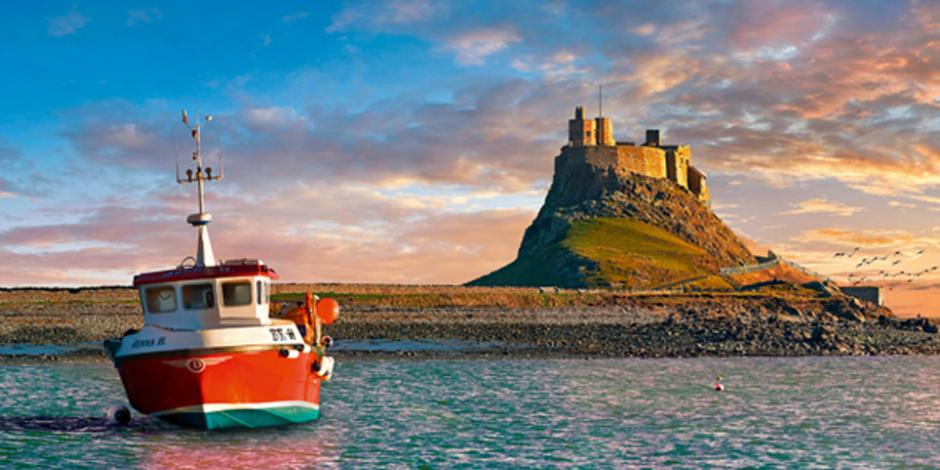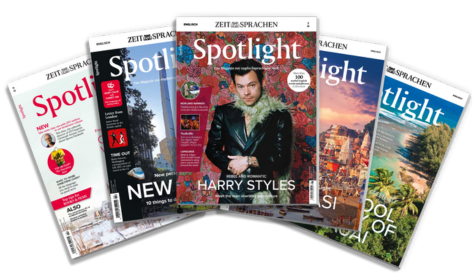England’s most northerly county is often ignored as people speed through it on their way to Scotland or, in the other direction, to places further south. Big mistake!
Both wild and beautiful, Northumberland is England’s least-populatedbesiedeltpopulated county, with large areas of hills and moorland and 65 kilometres of protectedhier: unter Naturschutz stehendprotected coastline. As a border territory, it was fought over by the English and the Scots. Not surprisingly, it has more castles than any other part of the country.
So, where to explore? If you’re a first-time visitor, take the coastal route. As well as empty beaches, wonderful birds and wildlife, mysterious islands, grand castles and beautiful gardens, there’s seafood so fresh that it almost jumps on to your plate. I’ve already packed my bags…
Day 1: seafood and a touch of poison
Leaving busy Newcastle behind, I turn off the main road towards Druridge Bay. No matter how often I visit, I still find it fascinating when the view opens up over the sand dunes to eight empty kilometres of palehellpale sand. I long to go for a walk – Northumberland’s beaches are more for walking than sunbathing, as the wind off the North Sea can be cold – but there’s plenty of time for that later.My next stop is Amble, a compact fishing town with a modern harbour. If I were staying a few days longer, I’d take a boat trip to Coquet Island; its bright white lighthouseLeuchtturmlighthouse shines a couple of kilometres away.
Home to around 40,000 seabirds, the small, rocky island is a protected bird sanctuaryVogelschutzgebietbird sanctuary. The puffinPapageitaucherpuffins are the main attraction: comical little birds with bright orange beakSchnabelbeaks, known as “the clowns of the sea”. Me? I’m to headsich aufmachenheading to the Fish Shack for a bowl of fish chowderSuppe aus Fisch und Meeresfrüchtenfish chowder. With crabKrebscrabs and lobsterHummerlobsters brought straight from the harbour, the seafood couldn’t get any fresher.
I head north again, turning inland towards Alnwick Castle, the largest house in Northumberland. Home to the dukeHerzogDuke and duchessHerzoginDuchess of Northumberland, this is the second-largest inhabited castle in the UK, after Windsor. The moatBurggrabenmoats, rampartFestungswallramparts and towers make it everything a castle should be. The rooms shine with silk wallpaperTapetewallpaper and Renaissance works of art. It’s not surprising that Alnwick was used as Hogwarts in two of the Harry Potter films and in two Christmas specials of Downton Abbey.
Next to the castle is the Alnwick Garden, where I try not to get lost in the labyrinth; I breathe in the perfume of 3,000 roses and admire the Grand Cascade fountainSpringbrunnenfountain. In the small Poison Garden, I discover that many innocent-looking plants aren’t as harmless as they appear. Who knew that laurelLorbeerlaurel was a source of cyanideZyanid, Blausäurecyanide?
Time for a beach walk at nearby Alnmouth, a pretty village of tea rooms, seafood restaurants, beautiful cottages and Victorian villas. This was a busy port until 1806, when a storm changed the courseVerlaufcourse of the River Aln, leaving it unable to take large ships.
Day 2, morning: gardens and ruins
Today, there’ll be more fish to eat, but first, I call at Howick Hall, where the gardens are the opposite of Alnwick’s stylized designs. The romantic wildflower meadowWiesemeadows, woodland garden (lovely in June, with jewel-coloured rhododendrons), bog gardenSumpfgartenbog garden and arboretum all offer plenty of secret places to escape from other visitors.
Howick Hall is the home of the Grey family (now owned through the female line), whose most famous ancestorVorfahr(in)ancestor was the 2nd earlGrafEarl Grey, a British prime minister in Victorian times. He’s perhaps most famous for the tea that was created in his honour. The story goes that a Chinese friend of the earl’s designed Earl Grey tea to suit the taste of the local water, adding bergamot to improve the flavour. From Howick, it’s a couple of kilometres north to the fishing village of Craster. Slowly, I walk towards the harbour, breathing in the rich smells from L. Robson’s kipperRäucherheringkipper smokehouses long before I see them.
At the height of the fishing trade, 33 herring boats operated from Craster. The catch of fish was smoked as “kippers” over fires of white woodchips before being sent on the night train to London’s Billingsgate Fish Market – and to the breakfast tables of the capital. Although nowadays there are fishing quotas for the herring that are caught in the North Sea, smoking continues in the traditional way, using fish from Norway.
The harbour at Craster is so tiny, I wonder how fishing boats can fit through the entrance. From here, it’s a windy, half-hour walk to the stark ruins of Dunstanburgh Castle, silhouetted to the north.
Built by the wealthy Earl Thomas of Lancaster, the 14th-century castle was designed on a grand scale. The earl later rebelled against King Edward II and was executed in 1322. But the castle continued to play an important defensive role in England, especially against the invading Scots.
Walking to the edge of the headlandLandspitzeheadland, with the wind to whippeitschenwhipping my hair and the sea to churnbrodeln, schäumenchurning far below, I can imagine what a wild and unfriendly place this must have been in those times. At least I can hurry back to the Jolly Fisherman village pub, to enjoy a steaming bowl of crab soup.
Afternoon: the darling of the nation
I spend a lazy afternoon dipping in and out of beaches: Embleton Bay (wide and open), Low Newton-by-the-Sea (overlooked by an excellent pub, the Ship Inn, with its own microbreweryHaus-, Kleinbrauereimicrobrewery) and the shelteredgeschütztsheltered bay at Beadnell. I end up at Seahouses, an old-fashioned little seaside resortBadeortseaside resort with a handful of gift shops, an amusement arcade and crazy golf (UK)Minigolfcrazy golf, a game in which golf balls are hit through various obstacleHindernisobstacles – mini lighthouses or tunnels – to reach the hole. Very British!
The main visitor attraction at Seahouses is a ferry trip to the Farne Islands, a group of around 20 small, rocky islands, clearly visible from the shore. The Farnes are home to huge colonies of seabirds and a large colony of Atlantic grey sealKegelrobbeAtlantic grey seals. The UK is home to nearly 40 per cent of these seals. They can often be seen lying on the rocks, like sunbathers; listen carefully, and you’ll hear them “singing”.
And then there’s the Victorian heroineHeldinheroine, Grace Darling. On 7 September 1838, 22-year-old Grace, daughter of the lighthouse keeper of Longstone Rock, to rowrudernrowed with her father in stormy seas to rescue the survivors from a steamship that had been to wreckSchiffbruch erleidenwrecked on the rocks of a neighbouring island. Father and daughter risked their lives and Grace won the hearts of the nation. Tomorrow, I’ll learn more about this brave young woman – but, right now, fish and chips are calling.
Day 3: the Holy Island of Lindisfarne
If you think Dunstanburgh was unfriendly, wait until you see Bamburgh Castle. Rising some 45 metres above the sea on volcanic rocksVulkangesteinvolcanic rocks, it seems to fill the sky as I make the short drive north from Seahouses. Built in the 11th and 12th centuries, Bamburgh became an important fortressFestungfortress against the Scots, as well as a royal palace.
In 1894, the castle was bought by the Victorian industrialist and inventor Lord William Armstrong. It’s usually open to the public. The castle is well worth a visit for the impressive views from the battlements.
A short walk from the castle, at the heart of the village, is the small Grace Darling Museum. Apart from portraits and an explanation of how a lighthouse works, what most fascinates me is the wooden boat that Grace and her father rowed in that famous rescue. It looks so fragilezerbrechlichfragile and tiny.
I take a walk on the sands beneath the castle and stare out at the Farne Islands. Holy Island – or Lindisfarne, to give it its Celtic name – is cut off from the mainland by the tidesGezeitentides twice a day. As I drive across the two-kilometre track (the Causeway), it hardly seems possible that the sea will come rushing in to cover the road in a few hours’ time.
Lindisfarne Island is mostly famous for St Cuthbert, who in the seventh century led a monastic communityKloster-, Ordensgemeinschaftmonastic community here, one of the great centres of Christianity. The ruins today are of the Norman prioryKlosterpriory that was built afterwards.
Most people, however, go first to Lindisfarne Castle, which stands on the rocks like a Lord of the Rings backdropKulissebackdrop. Built as a 16th-century fort to guard the coast, it actually saw little action and was to convertumbauenconverted in 1901 into a comfortable Edwardian home by the architect Edwin Lutyens.
To the northern edge of England
Before leaving the island, I head for the sand dunes on the north coast. I’ve been given a tip about finding rare orchidOrchideeorchids. No such luck, but I pass beautiful wildflower meadows, see colourful butterflies and hear the hauntingeindringlichhaunting cries of curlewBrachvogelcurlews.
My final stop is England’s northernmost town, Berwick-upon-Tweed, just a few kilometres from the Scottish border. Famous for its salmon, this tough-looking walled town on the River Tweed changed hands between England and Scotland many times before finally becoming part of England in 1482. The locals call themselves neither English nor Scottish, but “Berwickers”, and the town, too, has some interesting characteristics.
The design of the Elizabethan walls, for example, was based on a revolutionary Italian design. Originally built in the early 14th century, this is Britain’s most complete remaining set of town walls. And another interesting fact: if you decide to try the 100-kilometre-long Northumberland Coast Walk, you’ll get a free beer at the town’s tiny Curfew pub, marking the official end of the walk.
I choose the less difficult circular walk around the town walls, with their spectacular views of the coast and the town’s Georgian architecture. When I reach the estuaryFlussmündungestuary, I look upstream to the magnificent Royal Border Bridge. Designed by the engineer Robert Stephenson and opened by Queen Victoria in 1850, this railway viaduct spans the river in 28 elegant archBogenarches. I wait several minutes before, sure enough, a train comes into view. It’s exciting to watch it soundlessly glide along the bridge, high up in the air. Northumberland can indeed be a bewitchingbezauberndbewitching place to visit.
Neugierig auf mehr?
Dann nutzen Sie die Möglichkeit und stellen Sie sich Ihr optimales Abo ganz nach Ihren Wünschen zusammen.



